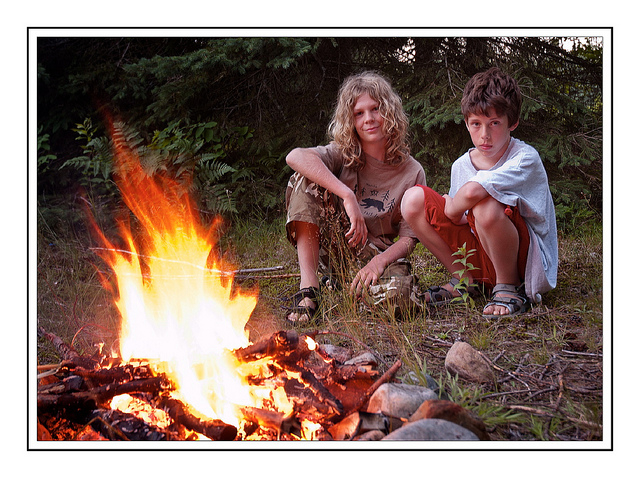Improve Your Family Storytelling: Tips and New Approaches
Some of the most memorable moments of childhood revolve around stories--stories told around a table, a campfire, a photo album, or at bedtime. I hope to take advantage of the family years by telling stories often and well! Here are some tips I'm learning to become a better storyteller:
Mural for Monserrat College of Art by Allison Cole, Illustration via Etsy
10 Ways to Improve Your Family Storytelling:
Photo by Denis Savard
- Start with stories you lived or loved at your child's age. What was your favorite book or movie? What did you love about those stories? What memorable life experiences did you have when you started preschool? When you went on a sleepover? When you first got your driver's license?
- Base your story around props or include humorous family knowledge. Feature your child's favorite stuffed animal, the family pet, or a common family scenario. One of my dad's favorite story starters was when one of us children accidentally flushed a cloth diaper and caused a citywide flood. This was not an entirely improbable situation since my mom often left my baby sister's cloth diapers soaking in the toilet.
- Include brief descriptions and sensory details. Young children especially appreciate colors and noises. And we all appreciate characters with whom we identify--either because we see ourselves in them, or because we want to be like them. My husband tells our children stories about two children whose names are remarkably similar to theirs.
- Include age-appropriate humor. While preschoolers enjoy nonsense words and extreme exaggerations, school-age children prefer unexpected juxtapositions ("But this hunting dog was afraid of squirrels") and teens enjoy irony and a well-timed twist. Adding humor may be as simple as making fun of yourself in the story.
- Multiply the danger if a story isn't holding their interest. (JakesTales.org, a storytelling site, says, "Toss in another bear--or better yet, two.")
- Lean in and gesture: Make frequent eye-contact with your kiddos and use your hands to illustrate sizes and actions.
- Use expressive voices and exaggerated emotions. Voices give characters credibility and personality. Whisper important details or bellow a gruff character's lines.
- Don't back up to add forgotten parts to the story--keep the story moving forward. You can adjust the story as you go to fit your audience's preferences, but deliver each line with confidence.
- Consider using a repeating phrase for predictability. Young children especially like predictability in stories. You've seen this technique in classic children's books; many of them hinge on phrases like "I think I can, I think I can"; and "I do not like green eggs and ham!"
- Keep it short and simple. Most memorable and beloved stories are less than ten minutes in the telling. (Make it a cliffhanger if it gets too long, and continue it another night.)
Allison Cole's Green Dragon Throw Pillow via Land of Nod
Adding Variety to Storytelling Routines:
- Memory games: After reading a short story, choose a family member to retell the story from memory. Afterwards, let other family members fill-in the forgotten or overlooked details, then re-read the story together again.
- Let your children take turns making key decisions in the story--everyone likes to have a say in how a story should play out.
- Tell stories in episodes. Stories don't have to be resolved in one sitting--but your children won't let you forget to finish it later! I still recall the first half of a vivid story from a childhood camp because I missed the event where the storyteller finished his story. I've often wondered about how the ending played out!
- Change your setting to enhance the senses. Dim the lights, light a candle, or usher everyone outside to huddle around a fire, because low light settings and nature bring our senses to life. It's easier to imagine a story's possibilities when our senses are heightened, and listeners feel closer to each other and the storyteller when they're united in a circle of light.
Feu de camp by Claude Robillard
I'm looking forward to telling a story that features our two cats or my daughter's beloved stuffed hamster. Which storytelling tips do you want to adopt soon?



